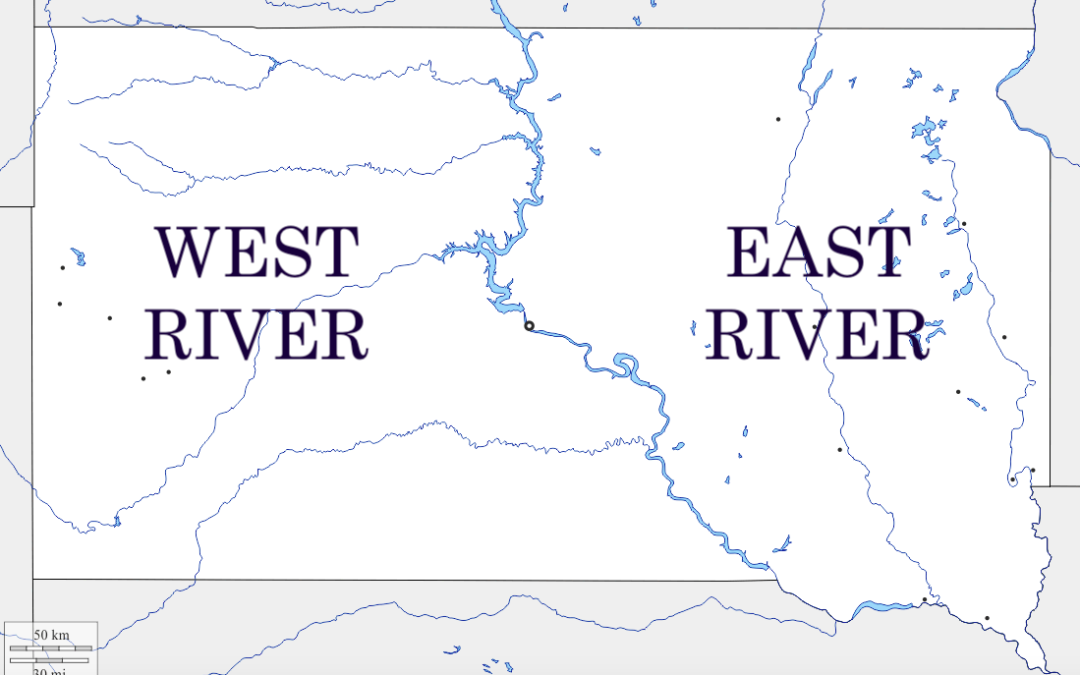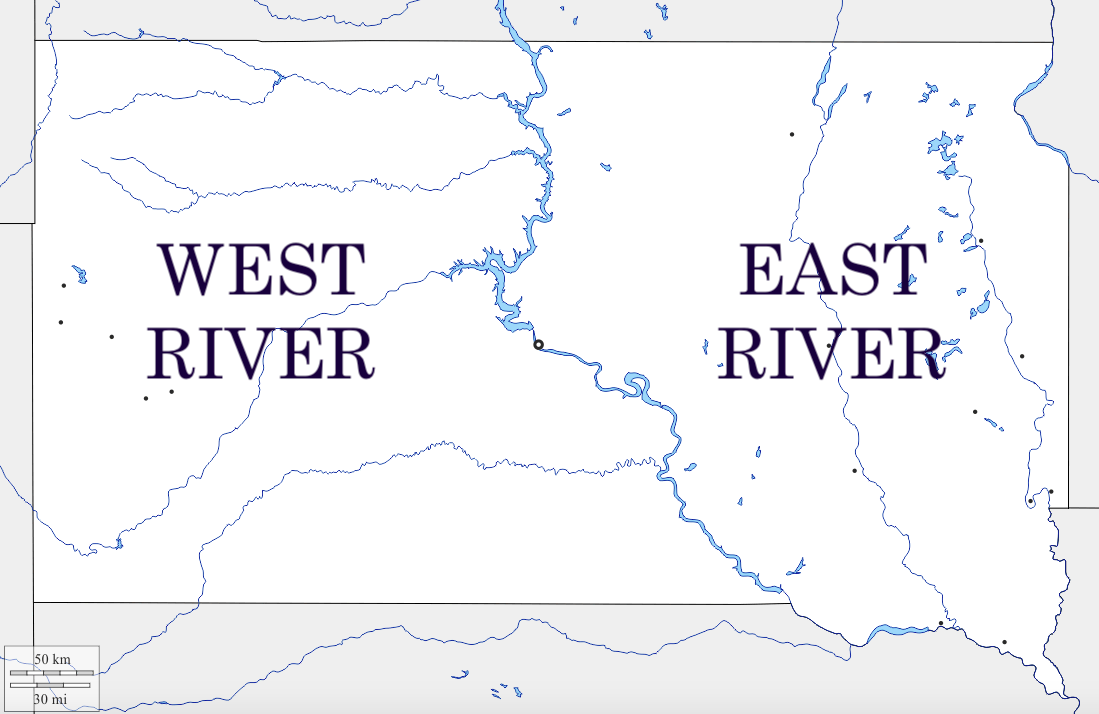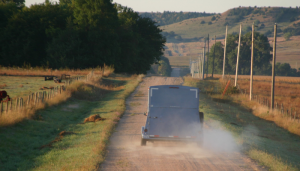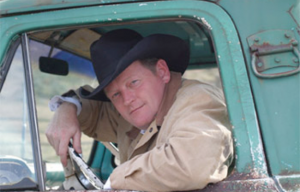
by jphilo | Nov 11, 2020 | Mystery Update

East River, West River is a phrase familiar to past and present citizens of the Dakotas. Everyone else in the world is most likely oblivious to East River, West River talk. If you’re among the oblivious ones–a group that included me until my husband and I moved to South Dakota–this quick tutorial is designed to enhance your understanding of a concept foundational to See Jane Run! and its sequels.
- The river referred to is the Missouri, which divides South Dakota into two neat halves. My spit spot Mary Poppins nature has always been grateful to have lived in South Dakota rather than in North Dakota, where the divide between east and west is messier.
- East River refers to counties east of the Missouri. West River refers to those west of the Missouri. Pretty simple, right?
- East River has farms. West River has ranches. Always remember that the words “farm” and “ranch” are NOT synonyms.
- East River is populated by farmers. West River is populated by cowboys. DO NOT confuse the two.
- The cultural divide between East and West River is far wider than the Mighty Missouri.
Last week I met with an editor who’s interested in publishing See Jane Run! and future books in the series. Exciting, yes, but all I can say until a contract has been signed is that things look promising. One reason is because the editor has an affinity for the region of the country where See Jane Run! is set. He has lived in both Dakotas and Montanas, so he gets the whole East/West, Farm/Ranch, Farmer/Cowboy business. Upon reading the manuscript, he immediately identified the culture shock experienced by Jane, the book’s protagonist and amateur sleuth, as a crucial element of the story.
Something we discussed in our 2 hour virtual meeting was how to communicate that element effectively. One easy way, I realized as we talked, was to change the series’ name from “The Tipperary County Mysteries” to “The West River Mysteries.” Not only does the change magnify the cultural divide, it also expands the setting from a single fictional South Dakota county to anywhere west of the Missouri River. Oh, the possibilities!
Whether you live East River, West River or up a creek without a paddle, I’d love to hear what you think of the change. Also, I promise to make a big announcement with all the juicy details once a book contract has been signed.
Sign up to receive website updates and See Jane Run! book news on Gravel Road’s home page right under the picture of–you guessed it–the gravel road.

by jphilo | Sep 22, 2011 | Out and About

The popularity of the recent My Cow-Hating Man post made clear that numerous readers wouldn’t sleep at night until the final chapter in Hiram’s working-cows-with Donnie saga has been told.
And we can’t have that, now can we?
First of all, Hiram chose to not document his day on a horse with a cell phone photo, so my quick pic of the horse trailer galloping into the distance is the only pictorial record available. That and Hiram’s rather sunburned neck. But the reluctant cowboy wasn’t too keen on having that exhibit on record either.
All in all, Hiram survived the day very well, even enjoyed part of it, he says. The sky was a clear blue, the breeze mild, the temperatures in the 70s, and the scenery spectacular. A perfect day for riding a horse and working cows, even for a man who’s not real hep on either prospect.
Also, the horse was well-trained and responsive. Donnie’s horses always are. And the cowboys and cowgirls watched out for Hiram, giving him jobs like opening the gate and guarding an escape hole in a cattle chute.
Kinda cowboy-in-training jobs, as opposed to Donnie’s job of heading contrary cows in the right direction by grabbing and twisting their tails. “They don’t like that,” Donnie explained. “They turn the right direction in a hurry.”
“I did not grab a cow’s tail,” Hiram clarified. “Those tails are covered with cow poop.”
No wonder we’ve stayed married for almost 35 years.
He’s a cow-hating man with a whole lot of horse sense.
Who could ask for anything more?

by jphilo | Jul 9, 2010 | Reviews

One of the best things in life – other than having a houseful of company for a child’s wedding, which is what we have now, so this post will be short – is stumbling upon an author who writes beautifully. Not too long ago I stumbled upon Craig Johnson, a western writer who defies the formulas traditionally used in the genre.
His protagonist in Sheriff Walt Longmire, who grew up on a Wyoming ranch, and left the west to play football in college. Sounds pretty traditional until Johnson saddles him with an English major, a stint in Viet Nam, and a propensity for playing Fats Waller tunes on the piano. His sidekick is his gigantic best friend and fellow football player Henry, also known as “the Cheyenne Nation.”
With this house full of wedding company, I don’t have time to detail what makes him so good, but here are a few tantalizing tidbits:
- He knows cowboys, and he knows ranch country so his writing is authentic. 7 years of living in cowboy country way back when makes me hard to please in this area, and Johnson pleases me just fine.
- His descriptions of the remote setting of his novels are accurate and poetic, the best I’ve read in a long time.
- Walt Longmire is a complex character, so human I sometimes think he’s one of the ranchers we knew in our days out west.
- He skillfully weaves phrases like “I felt like I was leaking time” into his prose. Love them, love them, love them.
Johnson has written several books in the Walt Longmire series. So far I’ve read two – out of order, unfortunately – and can’t wait to go back and read them all in the order they were written. A recent review by Oline H. Cogdill says his newly released Junkyard Dogs is the best Sheriff Walt mystery yet.
But don’t take her word for it. Or mine either. Try Johnson out and see what you think. And don’t be surprised if you schedule a vacation in Wyoming after reading one or two of his novels. He’s that good.





